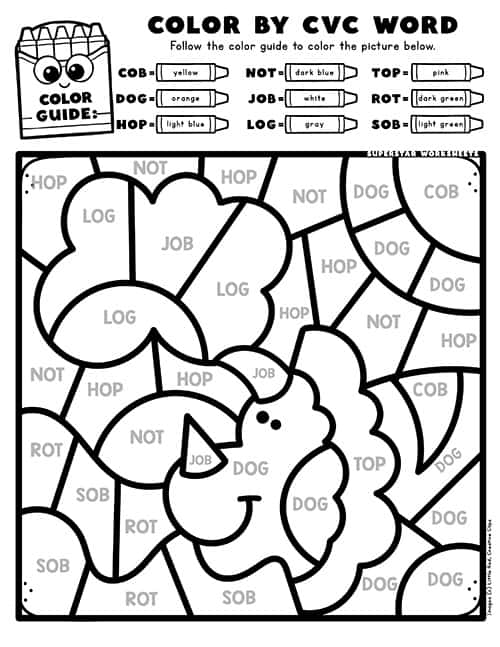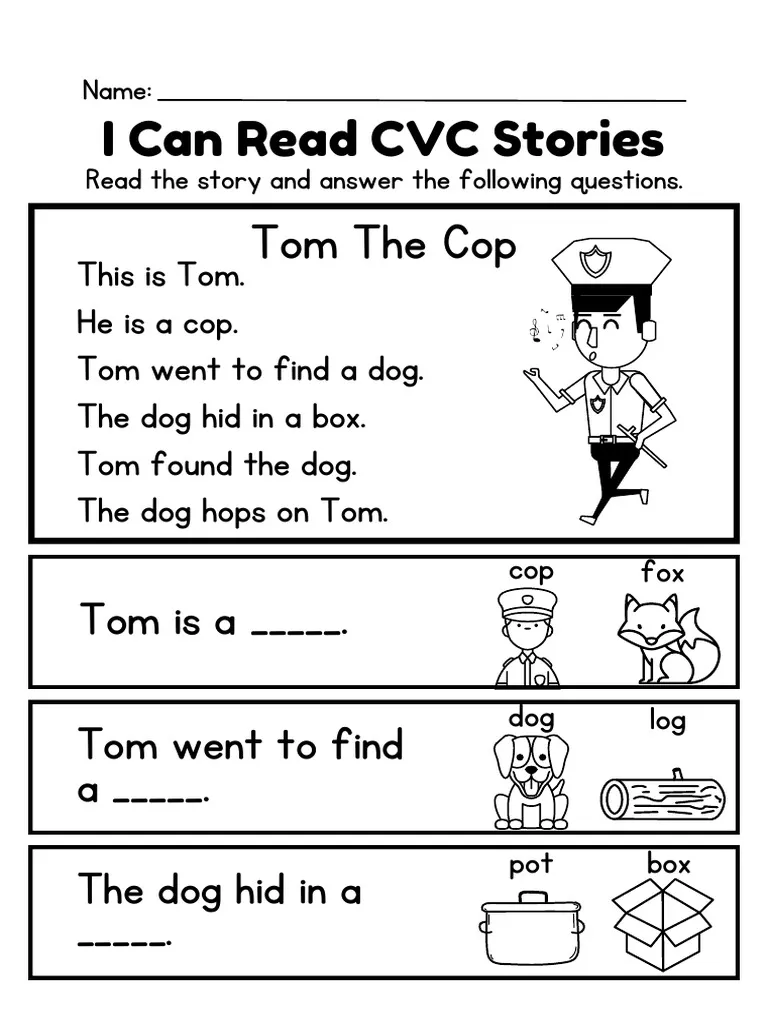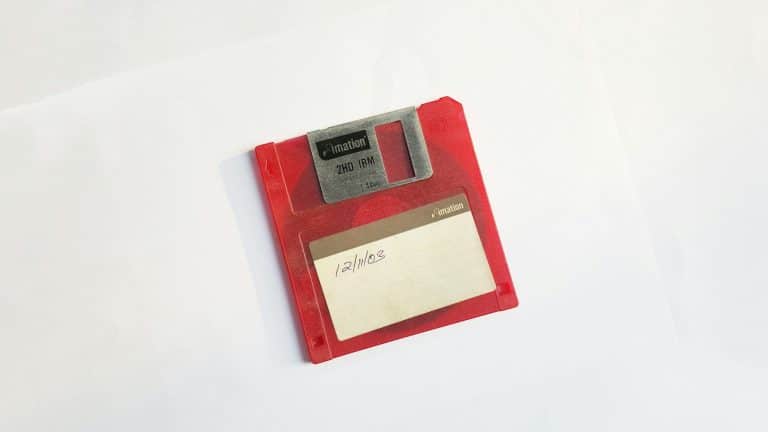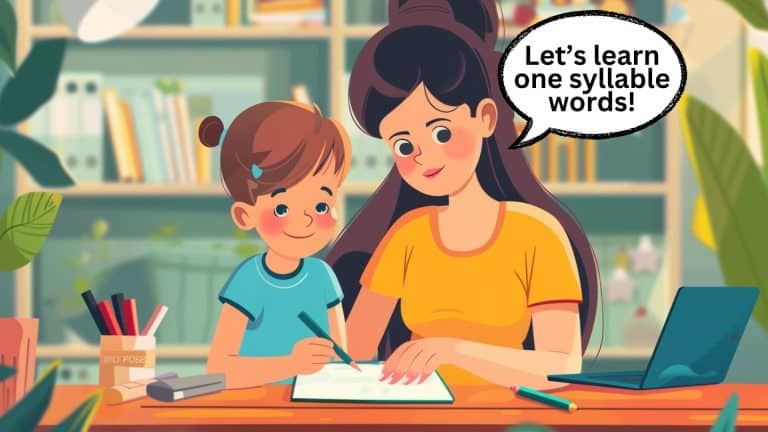7 Fun CVC Word Worksheets with Pictures for Preschoolers
Engaging CVC word worksheets are essential for helping preschoolers master basic reading skills.
However, finding activities that keep young learners interested can be a challenge.
The solution?
Fun, picture-filled worksheets that make practicing CVC words an exciting adventure.
In this article, we’ll share seven printable worksheets designed to captivate preschoolers as they learn to read simple three-letter words.
From connecting words to images to filling in missing letters, these activities will help children build a strong foundation in reading.
Get ready to watch your little ones grow in confidence and ability as they tackle these entertaining CVC word worksheets.
| Worksheet 1: Word & Picture Match | Phonics, Vocabulary | Reading, Word Recognition |
| Worksheet 2: Color by CVC Word | Phonics, Art | Reading, Color Recognition |
| Worksheet 3: Fill in the Missing Vowel | Phonics, Spelling | Vowel Recognition, Spelling |
| Worksheet 4: CVC Word Scramble | Spelling, Phonics | Spelling, Phonics |
| Worksheet 5: Rhyming CVC Words | Phonics, Rhyming | Phonemic Awareness |
| Worksheet 6: Tick the Correct Word | Reading, Phonics | Reading Comprehension |
| Worksheet 7: Complete the CVC Story | Storytelling, Phonics | Reading Comprehension, Creativity |
Worksheet 1: CVC Word and Picture Matching

Introducing the CVC Word and Picture Matching worksheet, a fantastic tool designed to help preschoolers develop their phonics skills by connecting visual cues with word recognition.
This engaging activity encourages young learners to match simple CVC words to their corresponding pictures, reinforcing the relationship between written language and real-world objects.
1. How it Works
The worksheet features a split layout, with colorful images on one side and CVC words on the other.
Children draw lines to connect each word to its matching picture, creating a clear visual link between them.
This hands-on approach keeps preschoolers actively engaged in the learning process.
2. Benefits
By associating sounds with visual representations, this matching activity
- Strengthens phonics awareness
- Enhances memory
- Enhances recognition skills.
As children work through the worksheet, they build confidence in their ability to identify and read CVC words, setting a strong foundation for future reading success.
3. Variations
Keep the learning experience fresh and challenging by introducing variations to the worksheet.
Try using it as a timed challenge, encouraging children to beat their records.
Alternatively, have children select a word from the list and draw their picture to represent it, further reinforcing the word-image connection.
4. Examples of CVC Words Used
The CVC Word and Picture Matching worksheet features a carefully curated selection of age-appropriate words, such as:
- cat
- dog
- sun
- hat
- pig
- bed
These simple yet diverse words expose preschoolers to various sounds and help them build a solid vocabulary foundation.
Worksheet 2: Color by CVC Word
Coloring is a beloved pastime for preschoolers and a powerful learning tool.
By combining phonics practice with the joy of coloring, this engaging worksheet reinforces letter-sound relationships and sight word recognition in a way that feels more like play than work.
1. How It Works
The Color by CVC Word worksheet features a series of outlined illustrations, each accompanied by a CVC word.
Children are given a color code that assigns a specific color to each word.
Their task is to identify the word, locate it on the code, and color the picture accordingly.
This hands-on approach keeps young learners engaged as they strengthen their reading skills.
2. Benefits
As children work through the Color by CVC Word activity,
- They develop critical phonemic awareness by associating sounds with visual elements.
- The act of coloring itself also promotes fine motor skill development
- Preschoolers learn to manipulate crayons or markers with increasing precision and control.
This combination of literacy and artistry creates a multisensory learning experience that appeals to various learning styles.
3. Engagement Tips
To maximize the educational value of this worksheet, encourage children to say each CVC word aloud as they color.
Ask questions about the objects being colored and the colors being used, promoting language development and color recognition.
Turning the activity into a conversation can deepen cognitive engagement and make learning more interactive.
4. Variations of the Worksheet
While coloring is a universally enjoyed activity, some children may prefer alternative methods of expression.
Consider offering stickers or stamps as a coloring substitute for those who struggle with fine motor control.
You can also adapt the worksheet to accommodate different learning levels by incorporating more advanced CVC words or focusing on specific short vowel sounds.
5. Integration with Other Learning Activities
The Color by CVC Word worksheet can easily be integrated into a larger learning theme.
- Use it on an art-focused day, where children explore colors and words through various mediums.
- Incorporate it into a phonics-themed week, dedicating each day to a different vowel sound and its corresponding worksheets.
- Contextualizing the activity within a broader learning framework creates a more cohesive and meaningful educational experience.
- The Color by CVC Word worksheet is a testament to the power of multisensory learning.
- Engaging children’s artistic and linguistic abilities simultaneously fosters a love for reading and a sense of accomplishment.
Embrace this worksheet’s versatility, and watch your preschoolers develop essential skills while having fun.
Worksheet 3: Fill in the Missing Vowel
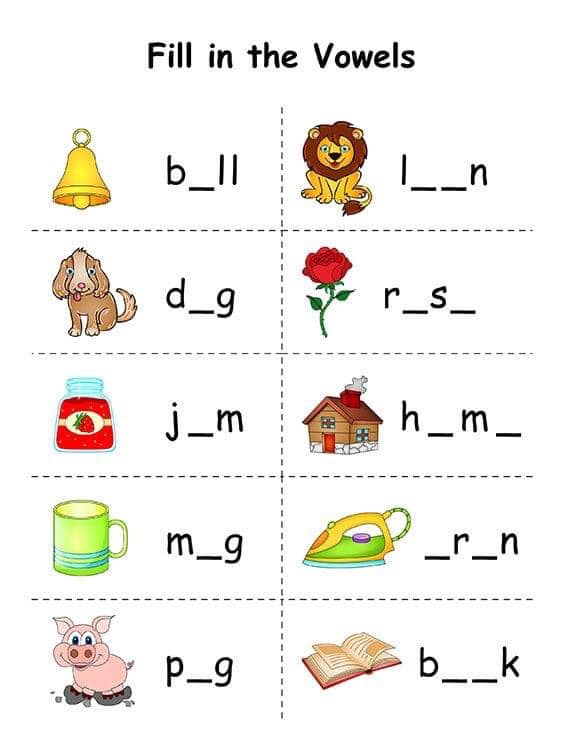
The Fill in the Missing Vowel worksheet is essential for helping preschoolers master vowel sounds, a crucial component of reading and phonetic awareness.
This activity presents Children with CVC words, but one vowel is missing.
Using picture clues and their knowledge of vowel sounds, they must identify and complete each word by filling in the appropriate missing vowel.
1. Clarification and Importance
This worksheet’s primary educational goal is reinforcing preschoolers’ understanding of vowel sounds.
Recognizing and distinguishing between short vowel sounds is a foundational skill that enables children to decode words and develop strong reading abilities.
The Fill in the Missing Vowel worksheet focuses on this key aspect of phonics and lays the groundwork for future reading success.
2. How It Works
To complete the worksheet, children should follow these steps:
1. Look at the picture beside each word.
2. Sound out the consonants in the word.
3. Determine which vowel sound completes the word based on the picture clue.
4. Write the missing vowel in the blank space.
Educators or parents can support children by encouraging them to say the sounds aloud, discussing the picture clues, and guiding them through the process of elimination to identify the correct vowel.
3. Engagement Tips
To make the activity more engaging and effective, consider these tips:
- Use colored pencils or markers to fill in the vowels, adding a visual and kinesthetic element to the learning process.
- Discuss each vowel’s sound and provide examples of other words that sound the same.
- Extend the activity by challenging children to brainstorm additional words with the same vowel sounds featured in the worksheet.
4. Extending Learning Beyond the Worksheet
Reinforce vowel sound recognition through supplementary activities such as
- Playing games that focus on identifying vowel sounds in words.
- I am using flashcards to practice matching vowel sounds to written letters.
- It engages with digital learning apps that provide interactive exercises focused on phonics and vowel sounds.
By combining the Fill in the Missing Vowel worksheet with these additional activities, preschoolers will gain a well-rounded understanding of vowel sounds and their role in reading, setting them up for long-term success in their literacy journey.
Worksheet 4: CVC Word Scramble
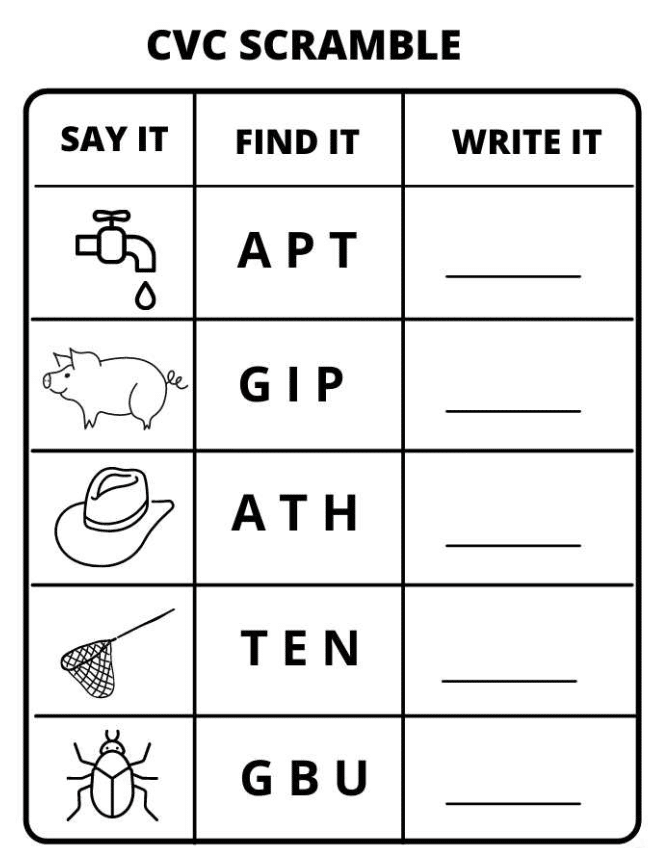
The CVC Word Scramble worksheet is an exciting and educational activity that challenges preschoolers to unscramble letters and form correct CVC words.
With the help of pictorial clues, children engage in a fun puzzle-solving experience that simultaneously develops their spelling and phonics skills.
1. Clarification and Importance
This worksheet offers two primary educational benefits
- Develop Spelling Skills: Children gain a hands-on understanding of word structures by manipulating scrambled letters to create words. Decoding and encoding words helps them internalize spelling patterns, improving spelling accuracy.
- Reinforce Phonics Knowledge: As children work to unscramble the letters, they must associate sounds with the visual representations of the letters. This process strengthens their phonemic awareness, a crucial foundational skill for reading success. The inclusion of picture clues further reinforces the connection between sounds and meaning.
2. How It Works
To maximize the benefits of the CVC Word Scramble worksheet, consider these implementation tips:
- Interactive Learning: Transform the worksheet into an engaging game by having children race against the clock to unscramble words or work in pairs to solve the puzzles together. This approach promotes active participation, teamwork, and communication skills.
- Progressive Difficulty: Begin with simpler words and gradually increase the complexity of the scrambles as children gain confidence and proficiency. This scaffolded approach ensures that children remain challenged but not overwhelmed, maintaining their motivation to learn.
- Feedback and Encouragement: Provide immediate feedback on children’s attempts, celebrate their successes, and offer gentle guidance when needed. Positive reinforcement is key to keeping children engaged and fostering a love for learning.
3. Engagement Tips
Extend the learning beyond the worksheet with these complementary activities.
- Creating Custom Scrambles: Encourage educators to create additional word scrambles using vocabulary from other lessons or words related to children’s interests. This personalization helps bridge new learning with familiar concepts, making the activity more meaningful and relevant.
- Word Creation Challenge: Challenge children to think creatively by forming new words, real or invented, using scrambled letters. This playful exploration of sounds and letter combinations promotes phonemic awareness and encourages experimentation with language.
4. Evaluating Progress
To gauge the effectiveness of the CVC Word Scramble worksheet and support student progress, consider these assessment and reflection strategies:
- Observational Notes: Throughout the activity, observe how children approach problem-solving, noting their strategies, struggles, and breakthroughs. These insights can inform future lesson planning and targeted support.
- Student Reflection: Engage children in discussions about their learning experiences, asking them to share what they found challenging, what they enjoyed, and what they discovered.
This feedback loop allows educators to adapt activities to meet individual needs and interests better.
By incorporating the CVC Word Scramble worksheet into your preschool curriculum, you provide children with a stimulating activity that builds essential literacy skills in a playful, engaging manner.
Through interactive learning, progressive challenges, and opportunities for reflection, children will develop a strong foundation in spelling and phonics, setting the stage for a lifetime of reading success.
Worksheet 5: Rhyming CVC Words
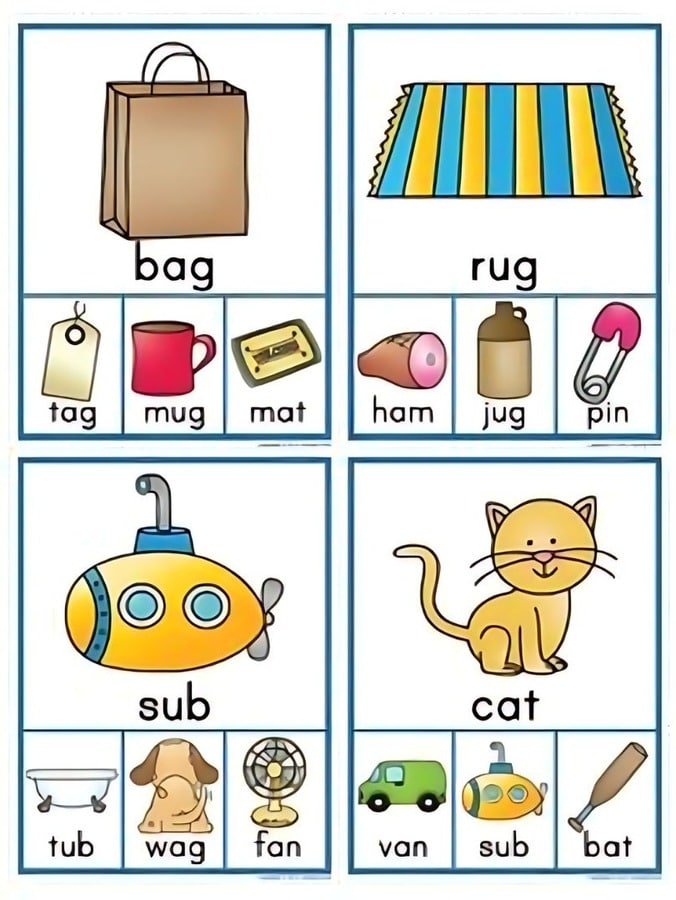
Rhyming is a fundamental component of phonemic awareness, a crucial skill in early literacy development.
This Rhyming CVC Words worksheet offers a fun, picture-based approach to help children connect rhyming sounds in an interactive and visually engaging manner.
The Rhyming CVC Words worksheet presents a series of carefully selected images and words with rhyming endings.
The worksheet uses color coding and arrows to link the rhyming pairs, making the connections clear and visually appealing.
This design enhances the visual learning experience, making the activity more engaging for young learners.
1. How It Works
To effectively use this worksheet, follow these simple steps:
1. Introduce the concept of rhyming words to the child, explaining that rhyming words have the same ending sound.
2. Present the worksheet and discuss the pictures and words shown. Encourage the child to say each word aloud, emphasizing the ending sounds.
3. Guide the child in connecting the rhyming pairs using the color-coded arrows. As they make each connection, have them vocalize the words again to reinforce the rhyming sounds.
4. Extend the learning by asking questions such as, “What sound do these words end with?” or “Can you think of another word that rhymes with these?” This discussion helps solidify the concept and encourages children to apply their knowledge beyond the worksheet.
2. Educational Benefits
The Rhyming CVC Words worksheet offers numerous educational benefits:
- Enhances Phonemic Awareness: Children develop the ability to hear, identify, and manipulate individual sounds within words by focusing on rhyming sounds. This skill is foundational for later reading success.
- Increases Engagement: Using pictures and interactive elements like color coding and arrows makes the learning experience more engaging and enjoyable for young children.
- Improves Memory Retention: Combining visual and auditory elements helps children form stronger connections between words and their sounds, leading to better memory retention.
3. Additional Tips and Resources
To further support children’s learning, consider these tips and resources:
- Play Rhyming Games: Engage children in games that involve identifying or producing rhyming words, such as “I Spy” or “Rhyme Time.”
- Read Rhyming Books: Incorporate books with rhyming text into your reading routine. This exposure reinforces the concept and helps children develop an ear for rhyme.
Create a Rhyming Word Wall
Dedicate a space in your classroom or home to display rhyming word pairs. Encourage children to contribute their discoveries to the wall.
Incorporating the Rhyming CVC Words worksheet into your early literacy curriculum provides children with a fun, engaging tool to develop critical phonemic awareness skills.
Through interactive learning and multi-sensory experiences, preschoolers will build a strong foundation in rhyming and be well-prepared for their future reading adventures.
Worksheet 6: Tick the Correct Word

We are introducing the Tick the Correct CVC Word worksheet, a valuable tool designed to enhance reading accuracy and fluency in young learners.
This engaging activity challenges students to identify and select the correct CVC word that matches a given picture, strengthening their ability to recognize words quickly and accurately.
1. How It Works
Each Tick the Correct CVC Word worksheet page features carefully chosen pictures.
Accompanying each picture are a few options of CVC words, one of which correctly corresponds to the image.
Students must analyze the picture, sound out the word options, and choose the correct word by ticking the corresponding box.
This process encourages children to connect visual and written representations of words, reinforcing their reading skills.
2. Benefits Of the Worksheet
This worksheet offers several key educational benefits:
- Improved Reading Accuracy: By practicing selecting the correct word to match a picture, students enhance their ability to recognize words accurately, a critical component of reading fluency.
- Enhanced Visual Association: Connecting images with their corresponding words strengthens students’ visual association skills, making it easier to recall and recognize words in the future.
- Increased Phonetic Awareness: As students use word options to determine the correct choice, they reinforce their understanding of phonetic sounds and their role in forming words.
3. Enhancement Tips
Consider these tips to maximize the impact of the Tick the Correct CVC Word worksheet.
- Encourage Verbal Participation: Before marking the correct word, have students discuss each picture and the word options aloud. This verbal engagement reinforces phonetic sounds and word recognition.
- Provide Immediate Feedback: Review the completed worksheet with students, offering praise for correct answers and gentle guidance for any mistakes. This feedback helps solidify learning and maintains motivation.
- Adapt to Individual Needs: If a student struggles with certain words or sounds, provide additional support or create customized worksheets focusing on their specific areas of need.
4. Supplemental Activities
Extend the learning experience beyond the worksheet with these complementary activities:
- Picture Drawing: Have students draw pictures representing the CVC words they’ve learned, reinforcing the connection between words and their visual representations.
- Flashcard Fun: Create flashcards featuring the CVC words from the worksheet. Use these to build fluency for quick recognition practice, games, or timed challenges.
- Word Hunts: Please encourage students to find and highlight the CVC words they’ve learned in age-appropriate texts, reinforcing their ability to recognize them in context.
Regular practice with the Tick the Correct CVC Word worksheet and related activities is essential for building a strong foundation in reading skills.
By consistently engaging with these educational tools, young learners will develop the accuracy, fluency, and confidence needed to become successful readers.
Embrace the power of this worksheet and watch your students’ reading abilities soar.
Worksheet 7: Complete the CVC Story
Storytelling is a powerful tool in early childhood education, captivating young minds and fostering a love for language.
The Complete the CVC Story worksheet seamlessly integrates this engaging learning approach with developing essential reading skills.
This worksheet offers a fun and educational experience that will leave a lasting impact.
It immerses children in the story-making process while reinforcing their understanding of CVC words.
The Complete the CVC Story worksheet features a visually appealing layout to capture children’s interest.
Each story is accompanied by delightful illustrations that provide context and support comprehension.
The stories are strategically crafted to include blanks where CVC words are missing, inviting children to participate actively in the storytelling process.
1. Interactivity
As children progress through the worksheet, they encounter gaps in the story where CVC words should be.
This interactive element challenges them to apply their phonetic knowledge and choose the appropriate word to complete the narrative.
By filling in the blanks, children reinforce their understanding of CVC words and develop a sense of ownership and pride in their role as story co-creators.
2. Skills Developed
The Complete the CVC Story worksheet promotes the development of several key literacy skills:
- Phonemic Awareness: As children read the story and fill in the missing words, they practice identifying and manipulating individual sounds within words.
- Word Recognition: Repeated exposure to cvc words in a meaningful context enhances children’s ability to recognize and decode them in future reading experiences.
- Vocabulary Building: Children who encounter new CVC words within the story expand their vocabulary and learn to use them in context.
- Comprehension: The story format encourages children to focus on understanding the narrative rather than just individual words, promoting early comprehension skills.
Guidance for Parents/Educators
To ensure children get the most out of the Complete the CVC Story worksheet, consider the following tips:
1. Set the Stage
Before diving into the worksheet, discuss the story’s title and illustrations with the children.
Ask questions that spark their curiosity and encourage them to predict the story.
2. Read Aloud
Read the story aloud, pausing at the blanks to allow children to fill in the missing CVC words.
Please encourage them to sound out the words and provide guidance when needed.
3. Celebrate Success
Praise children for their efforts and celebrate their achievements as they complete each story.
This positive reinforcement will boost their confidence and motivation to continue learning.
Conclusion
Engaging CVC word worksheets with pictures is essential for helping preschoolers develop strong reading skills.
These worksheets make learning fun and accessible by providing various interactive activities, such as matching words to images, coloring by CVC word, and completing CVC stories.
As children work through these exercises, they build crucial phonemic awareness, word recognition, and vocabulary skills, setting the foundation for future reading success.
Incorporate these worksheets into your early literacy curriculum and watch your young learners grow in confidence and ability.
Remember, consistency is key – regular practice with these engaging activities will help your preschoolers develop a lifelong love for reading.
So, choose a worksheet that resonates with your students, and let the CVC learning adventure begin!
Frequently Asked Questions
What Are CVC Words And Why Are They Important For Preschoolers?
CVC words contain consonants, short vowels, and consonants. They help preschoolers develop phonemic awareness and build a strong foundation for reading.
How Can Parents And Educators Effectively Use These CVC Worksheets At Home Or In The Classroom?
Introduce worksheets with enthusiasm, guide children through the activities, offer support and encouragement, and celebrate their progress to make learning engaging and effective.
What Age Group Are These CVC Worksheets Intended For?
These CVC worksheets are designed for preschoolers, typically ages 3-5, who are beginning to learn letter sounds and develop early reading skills.
Can These Worksheets Help Children With Learning Disabilities?
These worksheets can benefit children with learning disabilities by providing visual support, repetition, and hands-on practice to reinforce letter-sound connections and word recognition.
Where Can I Find More Resources For Teaching CVC Words To Preschoolers?
Additional resources for teaching CVC words include educational websites, teaching blogs, printable worksheets, CVC word games, and apps designed for early literacy development.


